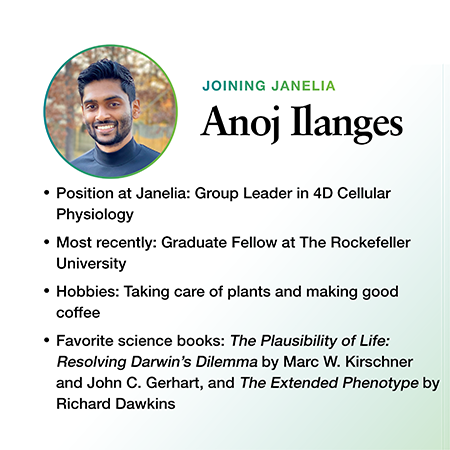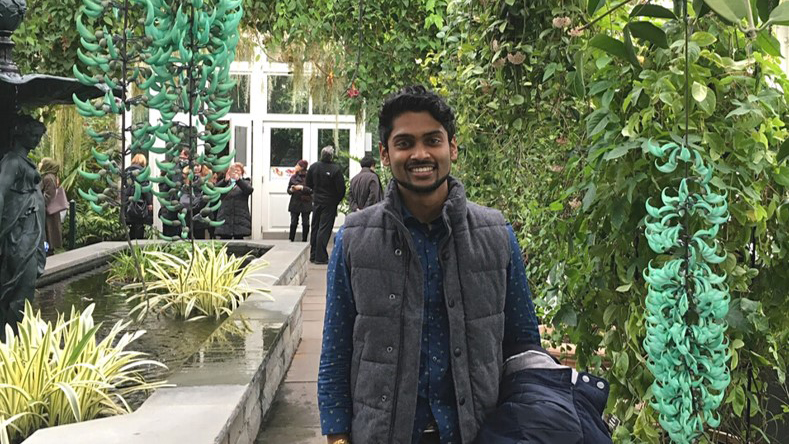Growing up, Anoj Ilanges was always interested in math and science. But it wasn’t until he worked in a lab at Mount Sinai Medical School that he really fell in love with biological research. A high school student at the time, Ilanges worked on genetic studies in fruit flies. He discovered the excitement of asking questions, carrying out experiments, and seeing what happens. This excitement led him to pursue a career in science – moving from genetics to neurobiology to immunology to neuroscience – and continues to motivate him in his current research to understand how all the organs of the human body function together.

HHMI Janelia: To start off, tell us a little bit about your research.
Anoj Ilanges: I’m interested in trying to understand how the brain interacts with the body to provide important aspects of control. Usually, we think of the brain being involved in aspects such as movement – that’s what people really associate with the brain. But the brain also plays an important role in controlling all aspects of physiology: our heart rate, breath rate, digestive function, as well as other things that are even harder for us to imagine, such as how our immune system works. The brain plays a central role in coordinating quite a lot. I’m interested in understanding how this is happening for different organs within our body, and how this is coordinated so that our body works.
One area that I’m really interested in is trying to understand how this coordination changes during critical states that we experience. One of those states is when we have an infection. With an infection, there are a lot of changes in the body: we have a fever, we feel nauseous. We’re not really interested in eating. A lot of functionality in our body changes in an abrupt manner when we get sick, and it's something we’re all aware of. Then it slowly, naturally, just goes back to being normal after we clear the infection. I’m really interested in trying to understand how the body induces this change and what role the brain plays in that. Then, how it’s returned to its normal state.
HJ: Why did you decide to come to Janelia to do this research?
AI: As someone who works in neuroscience, Janelia is this wonderful place that has a strong and rich history and is doing some phenomenal neuroscience. I’m partial to that, but then, what I’m really excited by – and the fact that neuroscience is also there helps with this – is that Janelia’s philosophy is around heavily collaborative projects, where there’s integration of different people with different perspectives, different expertise, to really try to hit hard on problems. For some of the areas that I’m interested in, it requires a lot of different perspectives, from people that really understand the brain, people that really understand different organs, and people that have the ability to bridge that.
That’s probably what makes it unique compared to other places – that it is a collaborative environment, plus the freedom that you get to work on these really ambitious questions without having to worry about trying to get things done in two years. I think it opens up possibilities in ways that other places just don’t have the ability to do.
HJ: You’re coming in as part of the new research area, 4D Cellular Physiology. What excites you about being part of this new direction?
AI: I think it’s exciting being there as the idea is forming and having a say in which direction the 4DCP initiative goes. I can’t think of another place with the initiative to bridge so many areas in a way that is uncompromising on the ability to do aspects really well in each of the different areas. 4DCP is bringing in experts in molecular biology, cell biology, neuroscience, and whole animal physiology and saying let’s work together to try to figure out real mechanisms and real solutions, not just superficial answers. I think that’s the only way you could work on these inherently interdisciplinary questions. Traditional departments don't really have the flexibility to do that. That’s one of the reasons why these questions haven’t been answered effectively up until now. I have a lot of faith that 4DCP has the right mentality to answer these questions.

HJ: You moved from New York City to the Janelia campus. Is there anything about living and working on the campus that you are most excited about?
AI: I’m looking forward to more of the outdoorsy, peaceful nature of the campus. Janelia is absolutely beautiful – not just the entire campus, but the whole area around it has such a good vibe. I appreciate a peaceful and quiet setting where you can actually get away from everyone for at least a little bit. I’m really looking forward to having the ability to do that. In New York, that’s near impossible.
I’m super grateful also that they take opportunities with younger scientists. I think it’s something that their philosophy is really based on – not so much on how many papers do you have or what productivity you have. I think they try to pick or select for people, and that’s something that I really appreciate and obviously benefit from, because I am on the younger side – I just finished up my PhD.
They’ve been just such wonderful people that I’m not worried at all about mentorship or jumping into these things alone, which is oftentimes how it feels when you go set up your own lab, and you're supposed to be independent. They’ve been so incredibly supportive that I feel I get to do another round of training but get to fake that I’m independent. I think that environment comes through, how they want to run things in a really supported manner. It’s good when you go to a place where it feels like the people really care for you to do well. That’s something I see at Janelia, and it was apparent from the start in my interactions with people.

Ilanges Lab / Animals can transition to and maintain vastly different physiological states, such as during infections. We use a combination of molecular, cellular, and systems level tools to study how the nervous system contributes to these processes.
